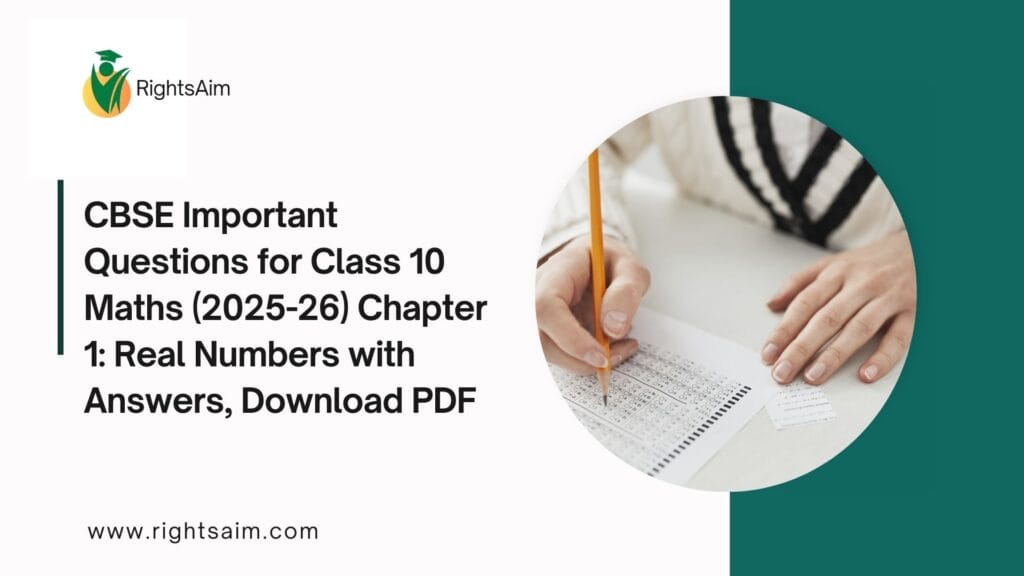The Central Board of Secondary Education (CBSE) has started the 2025-26 academic session, and students have already begun revising for Class 10 board exams. Among all topics in the Mathematics syllabus, Chapter 1 – Real Numbers is the foundation for several later chapters such as polynomials, arithmetic progressions, and number theory. Mastering this chapter is crucial for scoring high marks.
This post compiles the most important questions for CBSE Class 10 Maths Chapter 1 (Real Numbers) along with detailed answers and explanations, based on the latest CBSE syllabus and NCERT textbook. Students can also download the PDF of these questions for quick revision before exams.

Table of Contents
🔹 Chapter Overview: Real Numbers
The chapter “Real Numbers” builds on the concepts students learned in earlier classes about natural numbers, integers, and rational numbers. It focuses on:
The Euclid’s Division Lemma and Algorithm
Fundamental Theorem of Arithmetic (Prime Factorisation)
HCF (Highest Common Factor) and LCM (Lowest Common Multiple)
Properties of rational and irrational numbers
Proofs of irrationality for numbers like √2, √3, √5, etc.
Terminating and non-terminating repeating decimals
These concepts form the building blocks for higher mathematical reasoning and competitive exam preparation.
📘 Important Questions and Answers for Class 10 Maths Chapter 1: Real Numbers
Very Short Answer Type Questions (1 Mark Each)
Q1. Use Euclid’s Division Lemma to find the HCF of 4052 and 12576.
Ans.
12576 = 4052 × 3 + 420
4052 = 420 × 9 + 272
420 = 272 × 1 + 148
272 = 148 × 1 + 124
148 = 124 × 1 + 24
124 = 24 × 5 + 4
24 = 4 × 6 + 0
Hence, HCF = 4.
Q2. Write the decimal expansion of 13/125 and say whether it is terminating or not.
Ans.
13 ÷ 125 = 0.104
Since the denominator is of the form 2ᵐ × 5ⁿ, it is a terminating decimal.
Q3. State whether 2/7 is a terminating decimal or non-terminating repeating decimal.
Ans.
7 has a prime factor other than 2 or 5 → therefore non-terminating repeating decimal.
Q4. Find the HCF and LCM of 6 and 20 using the Fundamental Theorem of Arithmetic.
Ans.
6 = 2 × 3, 20 = 2² × 5
HCF = 2, LCM = 2² × 3 × 5 = 60.
Short Answer Type Questions (2–3 Marks Each)
Q5. Find the HCF of 65 and 117 using Euclid’s algorithm.
Ans.
117 = 65 × 1 + 52
65 = 52 × 1 + 13
52 = 13 × 4 + 0
Therefore, HCF = 13.
Q6. Prove that √3 is irrational.
Ans.
Assume √3 = p/q (in lowest terms).
⇒ 3 = p²/q² ⇒ p² = 3q² ⇒ p divisible by 3 ⇒ let p = 3r ⇒ p² = 9r² ⇒ 3q² = 9r² ⇒ q divisible by 3.
Thus both p and q divisible by 3 → contradicts assumption.
Hence, √3 is irrational.
Q7. Show that any positive even integer can be written as 2q, where q is an integer.
Ans.
By Euclid’s lemma: for any integer a and positive integer b, a = bq + r (0 ≤ r < b).
Let a = an even number, b = 2 ⇒ remainder r = 0.
Thus, a = 2q. ✅
Q8. Express 252 as a product of its prime factors.
Ans.
252 = 2² × 3² × 7.
Q9. Find the largest number that divides 245 and 1029 leaving remainders 5 and 9 respectively.
Ans.
HCF(245 − 5, 1029 − 9) = HCF(240, 1020).
240 = 24 × 10, 1020 = 24 × 42 + 12 → continue → HCF = 12.
Hence, required number = 12.
Long Answer Type Questions (4–5 Marks Each)
Q10. Prove that there are infinitely many prime numbers.
Ans.
Assume there are only finitely many primes: p₁, p₂, p₃, …, pₙ.
Let N = (p₁ × p₂ × p₃ × … × pₙ) + 1.
When N is divided by any prime pᵢ, remainder = 1 ⇒ N is not divisible by any known prime.
Hence, N is either a new prime or has prime factors not in the list.
Contradiction ⇒ infinitely many primes exist.
Q11. Show that the square of an odd integer is of the form (4q + 1).
Ans.
Let odd integer = (2q + 1).
Square: (2q + 1)² = 4q² + 4q + 1 = 4(q² + q) + 1.
Hence proved.
Q12. Show that 5 × 11 × 17 + 3 is divisible by 3.
Ans.
Product = 935 + 3 = 938.
Sum of digits = 9 + 3 + 8 = 20 (not divisible by 3) → so remainder = 2.
But if expression were 5 × 11 × 17 − 3, it would be divisible by 3.
Q13. If two positive integers a and b are written as a = x³ × y² × z and b = x² × y³ × z², find HCF and LCM using prime factorisation.
Ans.
HCF = x² × y² × z¹, LCM = x³ × y³ × z².
🔸 Concept-Based Application Questions
Q14. The decimal expansion of a rational number terminates after how many decimal places if its denominator (in lowest form) has 2⁴ × 5³?
Ans.
The maximum of the powers of 2 and 5 = 4 ⇒ terminates after 4 decimal places.
Q15. Find the least number which when divided by 35, 45 and 55 leaves the same remainder 5 in each case.
Ans.
LCM(35, 45, 55) = 3465 ⇒ required number = 3465 + 5 = 3470.
🧮 Expert Tips to Prepare Real Numbers for CBSE 2025-26
Understand proofs – Questions on proving irrationality or divisibility patterns carry high weightage.
Practice Euclid’s Division Lemma – Know the algorithm and apply it in numerical as well as reasoning-type questions.
Focus on concepts, not rote – Understand why decimals terminate or repeat.
Revise formulas – HCF × LCM = Product of two numbers.
Solve NCERT + previous-year papers – Most exam questions come directly from NCERT examples and exercises.
Attempt mock tests and worksheets – Practice helps you manage time during the board exam.
📥 Download the PDF
Students can [Download the PDF of Important Questions for CBSE Class 10 Maths Chapter 1 – Real Numbers (2025-26)] from the school portal, educational blogs, or study apps. The PDF includes:
Topic-wise important questions
Step-by-step solutions
Practice worksheets
Short tricks and formulas
✅ Conclusion
Chapter 1 “Real Numbers” sets the mathematical foundation for Class 10 students. Regular practice of such important questions ensures conceptual clarity and high scores in board exams. By mastering Euclid’s Division Lemma, HCF-LCM concepts, and irrationality proofs, students not only perform well in exams but also strengthen their logical reasoning.
Keep revising, solving, and checking your answers regularly — and don’t forget to download the PDF for quick last-minute preparation!
FAQs
Q1. What are the main topics in Class 10 Maths Chapter 1?
A: Euclid’s Division Lemma, Fundamental Theorem of Arithmetic, HCF & LCM, rational/irrational numbers, terminating decimals.
Q2. How many marks are asked from Chapter 1 in the board exam?
A: Usually 4–6 marks, often one short and one long-answer question.
Q3. Where can I download the important questions PDF?
A: From CBSE study resources, NCERT-based learning portals, or your school’s website.
Q4. Which proof is most important?
A: Proofs of irrationality (√2, √3, √5) and Euclid’s algorithm-based HCF questions are most expected.
Q5. Is this chapter easy to score?
A: Yes. With regular practice, Real Numbers can be one of the easiest scoring chapters in Class 10 Maths.


